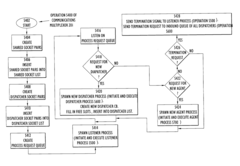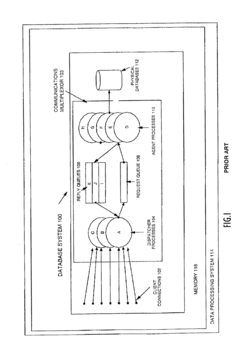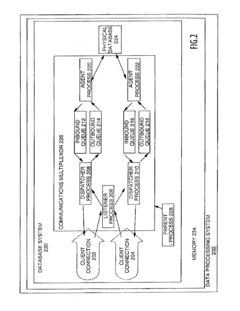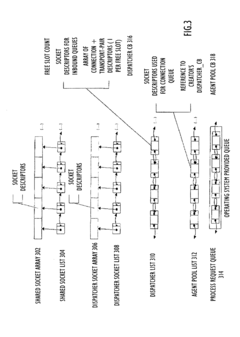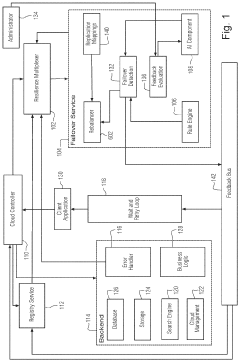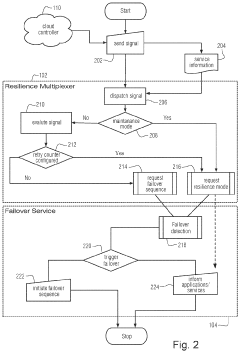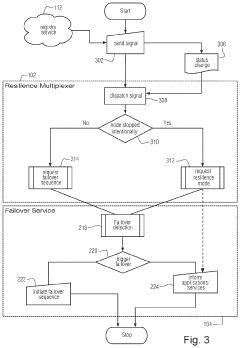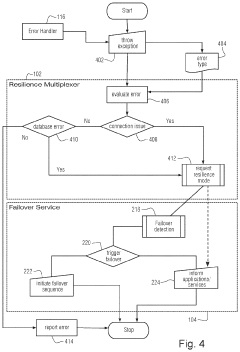Multiplexer Innovations Impacting Enterprise Data Centers
JUL 13, 20259 MIN READ
Generate Your Research Report Instantly with AI Agent
Patsnap Eureka helps you evaluate technical feasibility & market potential.
Multiplexer Evolution
The evolution of multiplexers in enterprise data centers has been marked by significant technological advancements and paradigm shifts. Initially, simple time-division multiplexing (TDM) techniques were employed to combine multiple low-speed signals into a single high-speed transmission. This approach, while effective, had limitations in terms of flexibility and scalability.
As data center demands grew, wavelength-division multiplexing (WDM) emerged as a game-changing technology. WDM allowed for the simultaneous transmission of multiple optical signals on different wavelengths over a single fiber, dramatically increasing bandwidth capacity. This innovation paved the way for dense wavelength-division multiplexing (DWDM), which further increased the number of channels that could be multiplexed on a single fiber.
The next major leap came with the introduction of optical add-drop multiplexers (OADMs). These devices enabled the selective addition or removal of specific wavelengths at intermediate points in the network, enhancing network flexibility and efficiency. Reconfigurable optical add-drop multiplexers (ROADMs) further improved upon this concept by allowing dynamic reconfiguration of wavelengths without manual intervention.
In recent years, the focus has shifted towards software-defined networking (SDN) and network function virtualization (NFV). These technologies have enabled the development of software-defined optical networks (SDONs), where multiplexing functions can be dynamically controlled and optimized through software. This has led to more agile and responsive data center networks capable of adapting to changing traffic patterns and service requirements.
The latest frontier in multiplexer evolution is the integration of artificial intelligence and machine learning algorithms. These technologies are being leveraged to predict network traffic patterns, optimize multiplexing configurations, and automate network management tasks. This trend is driving the development of cognitive optical networks that can self-optimize and self-heal, further enhancing the efficiency and reliability of enterprise data centers.
Looking ahead, the evolution of multiplexers is likely to continue in the direction of increased integration with other network technologies. This includes the convergence of optical and electrical multiplexing techniques, as well as the development of hybrid systems that can seamlessly switch between different multiplexing modes based on network conditions and requirements. As data center architectures continue to evolve, multiplexers will play a crucial role in enabling the high-speed, high-capacity, and low-latency communications necessary for next-generation enterprise applications and services.
As data center demands grew, wavelength-division multiplexing (WDM) emerged as a game-changing technology. WDM allowed for the simultaneous transmission of multiple optical signals on different wavelengths over a single fiber, dramatically increasing bandwidth capacity. This innovation paved the way for dense wavelength-division multiplexing (DWDM), which further increased the number of channels that could be multiplexed on a single fiber.
The next major leap came with the introduction of optical add-drop multiplexers (OADMs). These devices enabled the selective addition or removal of specific wavelengths at intermediate points in the network, enhancing network flexibility and efficiency. Reconfigurable optical add-drop multiplexers (ROADMs) further improved upon this concept by allowing dynamic reconfiguration of wavelengths without manual intervention.
In recent years, the focus has shifted towards software-defined networking (SDN) and network function virtualization (NFV). These technologies have enabled the development of software-defined optical networks (SDONs), where multiplexing functions can be dynamically controlled and optimized through software. This has led to more agile and responsive data center networks capable of adapting to changing traffic patterns and service requirements.
The latest frontier in multiplexer evolution is the integration of artificial intelligence and machine learning algorithms. These technologies are being leveraged to predict network traffic patterns, optimize multiplexing configurations, and automate network management tasks. This trend is driving the development of cognitive optical networks that can self-optimize and self-heal, further enhancing the efficiency and reliability of enterprise data centers.
Looking ahead, the evolution of multiplexers is likely to continue in the direction of increased integration with other network technologies. This includes the convergence of optical and electrical multiplexing techniques, as well as the development of hybrid systems that can seamlessly switch between different multiplexing modes based on network conditions and requirements. As data center architectures continue to evolve, multiplexers will play a crucial role in enabling the high-speed, high-capacity, and low-latency communications necessary for next-generation enterprise applications and services.
Data Center Demands
The demand for data center infrastructure continues to grow exponentially, driven by the increasing adoption of cloud computing, big data analytics, artificial intelligence, and the Internet of Things. Enterprise data centers are under pressure to handle massive volumes of data while maintaining high performance, low latency, and energy efficiency. This surge in data traffic and processing requirements has led to a critical need for innovative solutions in data center networking and interconnects.
Multiplexers play a crucial role in addressing these demands by enabling efficient data transmission and routing within data centers. As data rates continue to increase, traditional multiplexing technologies are reaching their limits, necessitating the development of advanced multiplexer innovations. These innovations are essential for supporting higher bandwidth, reducing power consumption, and improving overall data center performance.
One of the key drivers for multiplexer innovations is the need for higher data transmission speeds. With the transition from 100G to 400G and beyond, data centers require multiplexers capable of handling these increased data rates while maintaining signal integrity. This has led to the development of advanced modulation schemes and signal processing techniques to maximize the capacity of existing fiber infrastructure.
Energy efficiency is another critical factor driving multiplexer innovations in data centers. As data centers consume significant amounts of power, there is a growing emphasis on developing low-power multiplexer solutions that can reduce overall energy consumption without compromising performance. This includes the integration of advanced power management features and the use of more efficient materials and designs.
Space constraints within data centers are also pushing the boundaries of multiplexer design. The demand for higher port density and smaller form factors has led to the development of compact multiplexer solutions that can support more connections in a limited space. This trend towards miniaturization is essential for maximizing the utilization of valuable data center real estate.
Flexibility and scalability are becoming increasingly important in data center architectures. Multiplexer innovations are focusing on providing adaptable solutions that can easily scale to meet changing bandwidth requirements and support different network topologies. This includes the development of software-defined networking (SDN) compatible multiplexers that offer greater programmability and dynamic reconfiguration capabilities.
As data centers evolve to support edge computing and distributed architectures, there is a growing need for multiplexers that can operate effectively in diverse environments. This has led to the development of ruggedized and environmentally tolerant multiplexer solutions capable of functioning reliably in a wide range of conditions, from centralized data centers to edge locations.
Multiplexers play a crucial role in addressing these demands by enabling efficient data transmission and routing within data centers. As data rates continue to increase, traditional multiplexing technologies are reaching their limits, necessitating the development of advanced multiplexer innovations. These innovations are essential for supporting higher bandwidth, reducing power consumption, and improving overall data center performance.
One of the key drivers for multiplexer innovations is the need for higher data transmission speeds. With the transition from 100G to 400G and beyond, data centers require multiplexers capable of handling these increased data rates while maintaining signal integrity. This has led to the development of advanced modulation schemes and signal processing techniques to maximize the capacity of existing fiber infrastructure.
Energy efficiency is another critical factor driving multiplexer innovations in data centers. As data centers consume significant amounts of power, there is a growing emphasis on developing low-power multiplexer solutions that can reduce overall energy consumption without compromising performance. This includes the integration of advanced power management features and the use of more efficient materials and designs.
Space constraints within data centers are also pushing the boundaries of multiplexer design. The demand for higher port density and smaller form factors has led to the development of compact multiplexer solutions that can support more connections in a limited space. This trend towards miniaturization is essential for maximizing the utilization of valuable data center real estate.
Flexibility and scalability are becoming increasingly important in data center architectures. Multiplexer innovations are focusing on providing adaptable solutions that can easily scale to meet changing bandwidth requirements and support different network topologies. This includes the development of software-defined networking (SDN) compatible multiplexers that offer greater programmability and dynamic reconfiguration capabilities.
As data centers evolve to support edge computing and distributed architectures, there is a growing need for multiplexers that can operate effectively in diverse environments. This has led to the development of ruggedized and environmentally tolerant multiplexer solutions capable of functioning reliably in a wide range of conditions, from centralized data centers to edge locations.
Multiplexer Challenges
Multiplexers play a crucial role in enterprise data centers, enabling efficient data transmission and network management. However, as data center demands continue to evolve, multiplexers face several significant challenges that require innovative solutions.
One of the primary challenges is the ever-increasing demand for higher bandwidth and data transmission speeds. As enterprise applications become more data-intensive and real-time processing requirements grow, multiplexers must adapt to handle exponentially larger volumes of data without introducing latency or bottlenecks. This necessitates the development of advanced multiplexing techniques and hardware capable of supporting higher data rates.
Scalability presents another major hurdle for multiplexers in enterprise data centers. As organizations expand their infrastructure and adopt cloud-based solutions, multiplexers must be able to seamlessly scale to accommodate growing network complexity and traffic patterns. This includes supporting a wider range of protocols and interfaces while maintaining backward compatibility with existing systems.
Power consumption and heat dissipation pose significant challenges, particularly in high-density data center environments. As multiplexers handle increasing amounts of data, they generate more heat and consume more power. Developing energy-efficient multiplexing technologies that can operate reliably in compact spaces is crucial for sustainable data center operations.
Signal integrity and noise reduction become more critical as data rates increase. Multiplexers must maintain signal quality over longer distances and through various network components, minimizing signal degradation and crosstalk. This requires advanced signal processing techniques and improved materials for circuit design.
Security and data protection present ongoing challenges for multiplexers in enterprise data centers. As cyber threats evolve, multiplexers must incorporate robust security features to prevent unauthorized access and data breaches. This includes implementing encryption, access controls, and monitoring capabilities without compromising performance.
Flexibility and programmability are increasingly important as data center architectures become more dynamic. Multiplexers need to support software-defined networking (SDN) and network function virtualization (NFV) paradigms, allowing for rapid reconfiguration and adaptation to changing network requirements.
Lastly, cost-effectiveness remains a persistent challenge. While multiplexers must incorporate advanced features and capabilities, they also need to be economically viable for widespread adoption in enterprise data centers. Balancing performance improvements with cost considerations is crucial for multiplexer manufacturers and data center operators alike.
One of the primary challenges is the ever-increasing demand for higher bandwidth and data transmission speeds. As enterprise applications become more data-intensive and real-time processing requirements grow, multiplexers must adapt to handle exponentially larger volumes of data without introducing latency or bottlenecks. This necessitates the development of advanced multiplexing techniques and hardware capable of supporting higher data rates.
Scalability presents another major hurdle for multiplexers in enterprise data centers. As organizations expand their infrastructure and adopt cloud-based solutions, multiplexers must be able to seamlessly scale to accommodate growing network complexity and traffic patterns. This includes supporting a wider range of protocols and interfaces while maintaining backward compatibility with existing systems.
Power consumption and heat dissipation pose significant challenges, particularly in high-density data center environments. As multiplexers handle increasing amounts of data, they generate more heat and consume more power. Developing energy-efficient multiplexing technologies that can operate reliably in compact spaces is crucial for sustainable data center operations.
Signal integrity and noise reduction become more critical as data rates increase. Multiplexers must maintain signal quality over longer distances and through various network components, minimizing signal degradation and crosstalk. This requires advanced signal processing techniques and improved materials for circuit design.
Security and data protection present ongoing challenges for multiplexers in enterprise data centers. As cyber threats evolve, multiplexers must incorporate robust security features to prevent unauthorized access and data breaches. This includes implementing encryption, access controls, and monitoring capabilities without compromising performance.
Flexibility and programmability are increasingly important as data center architectures become more dynamic. Multiplexers need to support software-defined networking (SDN) and network function virtualization (NFV) paradigms, allowing for rapid reconfiguration and adaptation to changing network requirements.
Lastly, cost-effectiveness remains a persistent challenge. While multiplexers must incorporate advanced features and capabilities, they also need to be economically viable for widespread adoption in enterprise data centers. Balancing performance improvements with cost considerations is crucial for multiplexer manufacturers and data center operators alike.
Current MUX Solutions
01 Optical multiplexers
Optical multiplexers are used in fiber optic communication systems to combine multiple optical signals into a single fiber. These devices enable efficient transmission of multiple data streams over a single optical fiber, increasing bandwidth and reducing infrastructure costs. Optical multiplexers can be based on various technologies, including wavelength division multiplexing (WDM) and time division multiplexing (TDM).- Optical multiplexers: Optical multiplexers are used in fiber optic communication systems to combine multiple optical signals into a single fiber. These devices enable efficient transmission of multiple data streams over a single optical channel, increasing bandwidth and reducing infrastructure costs. Optical multiplexers can be based on various technologies such as wavelength division multiplexing (WDM) or time division multiplexing (TDM).
- Digital multiplexers for data communication: Digital multiplexers are essential components in data communication systems, allowing multiple digital signals to be combined and transmitted over a single channel. These devices are used in various applications, including telecommunications, computer networks, and digital broadcasting. Digital multiplexers can support different multiplexing techniques such as time division multiplexing (TDM) or frequency division multiplexing (FDM).
- Multiplexers in wireless communication systems: Multiplexers play a crucial role in wireless communication systems, enabling efficient use of the radio frequency spectrum. These devices allow multiple users or data streams to share the same frequency band or time slot, improving overall system capacity and performance. Wireless multiplexers can be implemented using various techniques such as code division multiple access (CDMA) or orthogonal frequency division multiplexing (OFDM).
- Multiplexers in display technologies: Multiplexers are used in display technologies to control and drive individual pixels or segments in various types of displays, such as LCD, LED, or OLED panels. These multiplexers enable the addressing and control of a large number of display elements using a reduced number of control lines, simplifying the overall display system design and improving performance.
- Analog multiplexers and signal processing: Analog multiplexers are used in signal processing applications to select and route analog signals from multiple input channels to a single output or processing stage. These devices are essential in various fields, including instrumentation, data acquisition systems, and audio/video processing. Analog multiplexers can be implemented using solid-state switches or relays, depending on the specific requirements of the application.
02 Digital multiplexers for signal processing
Digital multiplexers are essential components in signal processing and data communication systems. They are used to select and combine multiple input signals into a single output signal. These devices are crucial in various applications, including telecommunications, data transmission, and digital signal processing. Digital multiplexers can be implemented using various logic circuits and can handle different types of digital signals.Expand Specific Solutions03 Multiplexers in wireless communication systems
Multiplexers play a critical role in wireless communication systems, enabling efficient use of available frequency spectrum and improving overall system capacity. These devices are used in base stations and mobile devices to combine multiple input signals for transmission or separate received signals into individual channels. Multiplexers in wireless systems often employ advanced techniques such as frequency division multiplexing (FDM) and code division multiple access (CDMA).Expand Specific Solutions04 Multiplexers in display technologies
Multiplexers are used in various display technologies to control and drive individual pixels or segments. They enable the addressing and control of large arrays of display elements, such as in LCD or LED displays. These multiplexers help reduce the number of control lines required and improve the overall efficiency of display systems. They are crucial in creating high-resolution and responsive display devices.Expand Specific Solutions05 Analog multiplexers and switches
Analog multiplexers and switches are used to route analog signals in various electronic systems. These devices allow for the selection and routing of analog signals based on digital control inputs. They are essential in applications such as audio processing, data acquisition systems, and test and measurement equipment. Analog multiplexers can handle a wide range of signal types and frequencies, making them versatile components in many electronic designs.Expand Specific Solutions
Key Industry Players
The multiplexer innovations impacting enterprise data centers are in a dynamic phase of development, with the market experiencing rapid growth due to increasing data center complexity and demand for higher bandwidth. The technology is maturing, with key players like IBM, Qualcomm, and Microsoft driving advancements. These companies are focusing on improving data transmission efficiency, reducing latency, and enhancing overall network performance. The competitive landscape is intensifying as both established tech giants and specialized firms like Credo Technology Group and Inertech IP LLC vie for market share, pushing the boundaries of multiplexer capabilities in enterprise data center applications.
International Business Machines Corp.
Technical Solution: IBM has developed innovative multiplexer solutions for enterprise data centers, focusing on optical interconnects and silicon photonics. Their technology integrates multiple data streams onto a single optical fiber, significantly increasing bandwidth and reducing power consumption. IBM's multiplexers leverage wavelength division multiplexing (WDM) to transmit multiple signals simultaneously on different wavelengths[1]. This approach allows for data rates exceeding 100 Gbps per fiber, addressing the growing demand for high-speed data transmission in modern data centers[2]. Additionally, IBM has introduced advanced signal processing techniques to enhance the performance of their multiplexers, including adaptive equalization and forward error correction, which improve signal integrity and reduce bit error rates[3].
Strengths: High bandwidth capacity, reduced power consumption, and improved signal integrity. Weaknesses: Potential complexity in implementation and higher initial costs compared to traditional copper-based solutions.
Huawei Technologies Co., Ltd.
Technical Solution: Huawei has developed cutting-edge multiplexer solutions for enterprise data centers, focusing on high-density, energy-efficient designs. Their OptiXtrans DC908 platform utilizes advanced optical multiplexing techniques, including dense wavelength division multiplexing (DWDM) and optical time division multiplexing (OTDM)[7]. This technology enables up to 88 channels per fiber, each supporting data rates of 100 Gbps, resulting in a total system capacity of 8.8 Tbps[8]. Huawei's multiplexers also incorporate software-defined networking (SDN) capabilities, allowing for dynamic bandwidth allocation and network optimization. Additionally, they have implemented advanced forward error correction (FEC) algorithms to improve signal quality and extend transmission distances without the need for signal regeneration[9].
Strengths: Very high bandwidth capacity, SDN integration, and long-distance transmission capabilities. Weaknesses: Potential interoperability challenges with existing infrastructure and higher initial investment costs.
Core MUX Technologies
Communication multiplexor for use with a database system implemented on a data processing system
PatentInactiveUS20040122953A1
Innovation
- Implementing a communication multiplexor that manages multiple client connections using a pool of dispatcher processes, where requests are passed to agent processes, reducing the workload on dispatcher processes and utilizing a multi-queuing model with disjoint pools of shared socket pairs to improve scalability and performance.
Systems and/or methods for intelligent and resilient failover for cloud computing environments
PatentActiveUS20200092404A1
Innovation
- A resilience multiplexer is introduced to collect and process information from various components, using machine-learned rules and rule-based decision-making to determine whether a failover is necessary, and if so, to initiate a preprogrammed failover sequence only when predefined conditions are met, thereby reducing unnecessary failovers and improving handling of issues in distributed computing environments.
Energy Efficiency
Energy efficiency has become a critical concern in enterprise data centers, driving innovations in multiplexer technologies to reduce power consumption and operational costs. Modern multiplexers are designed to optimize energy usage through various techniques, significantly impacting the overall efficiency of data center operations.
One key innovation in multiplexer design is the implementation of advanced power management features. These include dynamic power scaling, where the multiplexer adjusts its power consumption based on traffic load and network demands. During periods of low activity, certain components can be put into low-power states or completely powered off, conserving energy without compromising performance when demand increases.
Another important development is the integration of more efficient optical components within multiplexers. The use of low-power lasers and high-sensitivity photodetectors reduces the energy required for signal transmission and reception. Additionally, improvements in optical modulation techniques allow for higher data rates with lower power consumption, enabling more efficient use of available bandwidth.
Thermal management innovations have also contributed to energy efficiency in multiplexer systems. Advanced cooling solutions, such as liquid cooling and heat-dissipating materials, help maintain optimal operating temperatures with less energy expenditure. This not only reduces direct power consumption but also decreases the load on data center cooling systems, leading to further energy savings.
The adoption of software-defined networking (SDN) principles in multiplexer design has introduced more intelligent traffic management capabilities. SDN-enabled multiplexers can dynamically route data through the most efficient paths, reducing unnecessary signal processing and minimizing energy waste. This adaptive approach ensures that energy is used only where and when it is needed, optimizing overall system efficiency.
Advancements in semiconductor technology have led to the development of more energy-efficient integrated circuits for multiplexers. The use of smaller process nodes and advanced materials has resulted in chips that consume less power while delivering higher performance. This trend continues to drive improvements in the energy efficiency of multiplexer systems, allowing for greater data throughput with reduced energy input.
These energy-efficient innovations in multiplexer technology are having a profound impact on enterprise data centers. By reducing power consumption, they not only lower operational costs but also contribute to sustainability goals by decreasing the carbon footprint of data center operations. As energy efficiency remains a top priority, ongoing research and development in multiplexer technology will continue to play a crucial role in shaping the future of green data centers.
One key innovation in multiplexer design is the implementation of advanced power management features. These include dynamic power scaling, where the multiplexer adjusts its power consumption based on traffic load and network demands. During periods of low activity, certain components can be put into low-power states or completely powered off, conserving energy without compromising performance when demand increases.
Another important development is the integration of more efficient optical components within multiplexers. The use of low-power lasers and high-sensitivity photodetectors reduces the energy required for signal transmission and reception. Additionally, improvements in optical modulation techniques allow for higher data rates with lower power consumption, enabling more efficient use of available bandwidth.
Thermal management innovations have also contributed to energy efficiency in multiplexer systems. Advanced cooling solutions, such as liquid cooling and heat-dissipating materials, help maintain optimal operating temperatures with less energy expenditure. This not only reduces direct power consumption but also decreases the load on data center cooling systems, leading to further energy savings.
The adoption of software-defined networking (SDN) principles in multiplexer design has introduced more intelligent traffic management capabilities. SDN-enabled multiplexers can dynamically route data through the most efficient paths, reducing unnecessary signal processing and minimizing energy waste. This adaptive approach ensures that energy is used only where and when it is needed, optimizing overall system efficiency.
Advancements in semiconductor technology have led to the development of more energy-efficient integrated circuits for multiplexers. The use of smaller process nodes and advanced materials has resulted in chips that consume less power while delivering higher performance. This trend continues to drive improvements in the energy efficiency of multiplexer systems, allowing for greater data throughput with reduced energy input.
These energy-efficient innovations in multiplexer technology are having a profound impact on enterprise data centers. By reducing power consumption, they not only lower operational costs but also contribute to sustainability goals by decreasing the carbon footprint of data center operations. As energy efficiency remains a top priority, ongoing research and development in multiplexer technology will continue to play a crucial role in shaping the future of green data centers.
Scalability Strategies
Scalability strategies for multiplexer innovations in enterprise data centers focus on enhancing the capacity and efficiency of data transmission and processing. One key approach is the implementation of advanced optical multiplexing techniques, such as Dense Wavelength Division Multiplexing (DWDM). This technology allows for the simultaneous transmission of multiple data streams over a single fiber optic cable, significantly increasing bandwidth capacity without the need for additional physical infrastructure.
Another crucial strategy involves the development of software-defined networking (SDN) solutions that can dynamically allocate network resources based on real-time demand. By decoupling the control plane from the data plane, SDN enables more flexible and efficient management of multiplexer resources, allowing data centers to scale their operations more effectively in response to changing workloads.
The integration of artificial intelligence and machine learning algorithms into multiplexer systems represents a forward-thinking scalability strategy. These technologies can predict traffic patterns, optimize routing decisions, and automate the reconfiguration of multiplexer settings, thereby enhancing overall network performance and adaptability.
Edge computing is emerging as a complementary approach to traditional centralized data center architectures. By distributing multiplexing capabilities closer to the data source or end-user, edge computing can reduce latency and alleviate bandwidth constraints on core network infrastructure. This distributed model supports scalability by offloading processing and routing tasks to edge nodes, enabling more efficient handling of increasing data volumes.
Advancements in silicon photonics are paving the way for more compact and energy-efficient multiplexer designs. These innovations allow for the integration of optical components directly onto silicon chips, potentially leading to higher-density multiplexing solutions that can support the growing demands of enterprise data centers while minimizing power consumption and physical footprint.
Lastly, the adoption of disaggregated hardware architectures is gaining traction as a scalability strategy. This approach allows data centers to independently upgrade or scale specific components of their multiplexing infrastructure, such as line cards or switch fabrics, without overhauling entire systems. This modularity provides greater flexibility in adapting to evolving technological advancements and changing capacity requirements.
Another crucial strategy involves the development of software-defined networking (SDN) solutions that can dynamically allocate network resources based on real-time demand. By decoupling the control plane from the data plane, SDN enables more flexible and efficient management of multiplexer resources, allowing data centers to scale their operations more effectively in response to changing workloads.
The integration of artificial intelligence and machine learning algorithms into multiplexer systems represents a forward-thinking scalability strategy. These technologies can predict traffic patterns, optimize routing decisions, and automate the reconfiguration of multiplexer settings, thereby enhancing overall network performance and adaptability.
Edge computing is emerging as a complementary approach to traditional centralized data center architectures. By distributing multiplexing capabilities closer to the data source or end-user, edge computing can reduce latency and alleviate bandwidth constraints on core network infrastructure. This distributed model supports scalability by offloading processing and routing tasks to edge nodes, enabling more efficient handling of increasing data volumes.
Advancements in silicon photonics are paving the way for more compact and energy-efficient multiplexer designs. These innovations allow for the integration of optical components directly onto silicon chips, potentially leading to higher-density multiplexing solutions that can support the growing demands of enterprise data centers while minimizing power consumption and physical footprint.
Lastly, the adoption of disaggregated hardware architectures is gaining traction as a scalability strategy. This approach allows data centers to independently upgrade or scale specific components of their multiplexing infrastructure, such as line cards or switch fabrics, without overhauling entire systems. This modularity provides greater flexibility in adapting to evolving technological advancements and changing capacity requirements.
Unlock deeper insights with Patsnap Eureka Quick Research — get a full tech report to explore trends and direct your research. Try now!
Generate Your Research Report Instantly with AI Agent
Supercharge your innovation with Patsnap Eureka AI Agent Platform!
